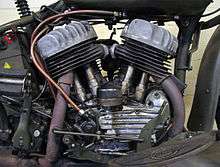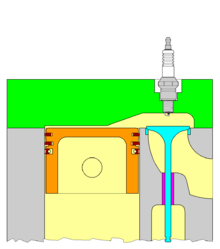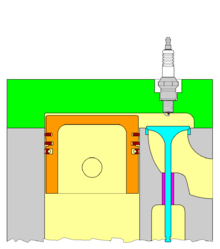Flathead engine


.jpg)

A flathead engine (aka sidevalve engine (SV), flathead, or flatty)[1] is an internal combustion engine with valves placed in the engine block beside the piston, instead of in the cylinder head, as in an overhead valve engine. As the cylinder cross-section has the shape of an upside-down L, other names such as L-block or L-head are also common.
The sidevalve's poppet valves are usually sited on one side of the cylinder(s). A recess in the cylinder head creates a corridor connecting the valves and the combustion chamber. The valve gear comprises a camshaft which operates the valves via simple tappets, most commonly without any further valvetrain components (such as pushrods, rocker arms, overhead valves or overhead camshafts). Indian, however, employs both rocker arms and pushrods to transmiit motion from the cam lobes to the valve stems.
The sidevalve arrangement was once the most common across all motor industries (automotive, agricultural, marine, aviation, and others), but it has since fallen from favor in most multicylinder applications, such as automotive and aviation, having been displaced by overhead valve designs. Flathead designs are still commonly built new for many small engine applications of one and two cylinders, such as lawnmowers, rotary tillers, and two-wheel tractors.
Advantages
The main advantages of a sidevalve engine are simplicity, reliability, cheapness, compactness, responsive low-speed power, low mechanical engine noise and insensitivity to low-octane fuel. The absence of a complicated overhead valve (OHV) valvetrain allows a compact engine that is cheaper to manufacture, as the cylinder head may be little more than a simple metal casting. These advantages may explain why OHV designs were first adopted only in high-performance applications such as aircraft, luxury cars, and sports cars, while economy cars, trucks, and agricultural engines continued to use flathead engines for some time. Even today, flatheads are common in lawnmowers and basic farm machinery.
An important benefit of the sidevalve design is that, if a valve should seize in its guide (remain partially open), only limited damage to that individual cylinder would occur, and an engine can often operate safely on its other cylinders with a seized valve. If a valve head breaks off, it may become lodged between the piston and the head causing severe damage.
At top dead centre, the piston gets very close to the flat portion of the cylinder head above, and the resultant squish turbulence gives excellent fuel/air mixing.
The typical flathead engine has its valves adjacent, but the "T-head" variant acts as a "cross-flow" head.
Disadvantages
The main disadvantages of a sidevalve engine are poor gas flow, poor combustion chamber shape, and low compression ratio, all of which result in a low power output.
The sidevalve configuration makes intake and exhaust gases follow a circuitous route, with low volumetric efficiency, or "poor breathing". Although a sidevalve engine can safely operate at high speed, its volumetric efficiency swiftly deteriorates, so that high power outputs are not feasible at speed. High volumetric efficiency was less important for early cars because their engines rarely sustained extended high speeds, but designers seeking higher outputs had to abandon the sidevalve. A compromise used by Willys (Jeep), Rover and Rolls-Royce in the 1950s was the F-head (aka intake-over-exhaust configuration), in which there is one side valve and one overhead valve per cylinder.[2]
An advance in flathead technology resulted from experimentation in the 1920s by Sir Harry Ricardo, who improved their efficiency after studying the gas-flow characteristics of sidevalve engines.[3]
Because the exhaust follows a lengthy path to leave the engine, there is a tendency for the engine to overheat. In a T-head engine, the sidevalve pairs have a crossflow configuration, so exhaust gases leave on the opposite side of the cylinder from the intake valve. American LaFrance powered their fire engines with T-head engines from the 1920s to the 1950s. The Cleveland Motorcycle Manufacturing Company produced a T-head four-cylinder in-line motorcycle engine in the 1920s, and early Stutz engines were T heads.
Potentials

Although both OHV and OHC engines have proved to be more efficient than flatheads, there is some potential to give flatheads better performance via advanced design features, such as:
- Pop-up pistons may be used with compatible heads to increase compression ratio and improve the combustion chamber's shape to prevent knocking.[4]
- Turbulence grooves may increase swirl inside the combustion chamber, thus increasing torque, especially at low rpm. Better mixing of the fuel/air charge improves combustion and helps to prevent knocking.[5][6][7][8]
- The traditional flathead engine suffers from its flat and elongated combustion chamber, which is prone to knocking if compression ratio is increased. Using improved ignition system such as laser ignition or microwave enhanced ignition could speed up the combustion and prevent knocking.[9]
History and applications
Flathead inline 4- and 6-cylinder engines were frequently used for automobiles (as with the famous Ford Model T), tractors, and other products from the beginning of the automotive industry until the 1950s, when overhead valve designs began to outnumber flathead designs in production numbers. Flathead designs are still commonly built new for applications such as lawnmowers, rotary tillers, two-wheel tractors, and other one- and two-cylinder equipment.
Some of the most famous automotive flathead engines were ones whose common nicknames reflected their flathead nature, such as the Ford flathead V8 engine and the Ford Sidevalve engine.
Due to cooling and efficiency problems, flathead engines fell out of favor in "high power" applications, such as aircraft engines, prior to World War I, with rare exceptions like the American Aeronca E-107 opposed twin aero engine of 1930. However they lived on for some time in the automotive world and were used on the Jeep, for instance. Flatheads are no longer in common use for automobiles (except in some rodding and customizing circles),[1][10] that most often use restored and reproduction examples of the classic 1932–1953 "model years" Ford flathead V8 engine, with the flathead valve configuration still used for some small-engine applications like lawnmowers. Because of their design, the size of valves and the compression ratio are limited, which in turn reduces available power and economy.[11]
Cadillac produced V-16 flathead engines for their Series 90 luxury cars during 1938–1940. They were known of their almost silent idle and very smooth torque.[12]
A new arrival is the Belgian D-Motor LF26, a compact 2.7-litre flat-four aero-engine that has direct drive to a propeller, rather than a reduction gearbox.[13] As the engine was designed to produce peak power of 90 bhp at only 2800 rpm, this very low engine speed meant the designers could dispense with the complexity of an ohv valvetrain. The resulting simplicity, lightness, compactness and reliability are ideal in an aero-engine.[14] D-Motor has developed a 125 bhp 6-cylinder version, the D-Motor LF39.[15]
Harley-Davidson motorcycle flathead engines
Model W, singles, and 45s (DL, RL, and WL)
The flathead engine saw service in Harley-Davidson motorcycles beginning with the Model W's flat-twin, produced from 1919 to 1923,[16] and continuing in 1924 with single-cylinder export-model 21-cubic-inch (340 cc) and 30.5-cubic-inch (500 cc) singles and continued in Servi-Cars until 1973. In the domestic U.S. market, the 45-cubic-inch (740 cc) (primary VIN letter) D model (1929 to 1931) and its technical descendant, the (primary VIN letter) R model (1932 to 1936), started Harley's side-valve tradition in the 45-cubic-inch displacement class. The D and R models featured a total-loss oiling system and were succeeded in 1937 by the (primary VIN letter) W 45, which had recirculating oil lubrication. The WLA (W = return oil, L = performance, A = army) went on to serve in World War II as the U.S. and Canadian Army's WLC (C = Canada) primary two-wheeled mount and subsequently as a civilian middleweight through 1952. The engine continued virtually unchanged with 2.745" bore and 3.8125" stroke with various G-based designations in the three-wheeled "Servi-Car" until production ceased in 1973.
K-series and developments
In 1952, the K series flatheads was introduced with the same bore and stroke, selling in parallel with the W series (which was discontinued after 1952), designed to compete with British sporting motorcycles of the time, as the American motorcycle Association allowed the 750 cc sidevalves a 50% displacement advantage to compete against 500 cc overhead valve bikes. The K models featured a unit construction engine and transmission case, right side foot shift and left side foot brake, and evolved from 45 cubic inches (1952 to 1953) to 54 cubic inches by a 0.75-inch (19 mm) increase in stroke length (1954 to 1956) to 4-9/16" over its five-year retail market run. The K series was replaced by the overhead valve Sportster series in the retail market in 1957. However, racing versions of the 750 cc K model (and some 900 cc KHR), designated KR, continued to be produced in very limited numbers for some time after, winning both roadraces and dirt track events against overhead valve bikes limited to 500 cc through 1969, when the American Motorcycle Association finally decided to change the rules by increasing the displacement to 750 cc, and removing the displacement advantage, making the venerable flatheads uncompetitive against 750 cc overheads.[17] The K racers were replaced first by the iron-head XR 750 cc overhead valve engine in 1970, and two years later by the alloy-head XR, which continues in service in flat track racing to this day.
Flathead big twins
In 1930, the 74-cubic-inch (1,210 cc) VL flathead replaced the JD Big Twin, which had featured intake-over-exhaust (IoE) valve configuration. The VL had a single downtube frame and total loss oiling, culminating in an 80-cubic-inch (1,300 cc) version (VLH) in 1935. In 1937, that engine was redesigned to include a recirculating lubrication system, and designated the model U, and it went into the same frame and running gear configuration as the model E Knucklehead, which had originated in 1936. The U continued to be produced in varying configurations as a 74 cubic inch U & UL (1937 to 1948), and 80 cubic inch UH & ULH engine (1937 to 1941). By that time, the first year of the aluminum-head Panhead, it had been thoroughly superseded and outsold in the marketplace by the superior performance of the overhead valve model Big Twins.
Notes
- 1 2 American Rodder, 6/94, pp.45 & 93.
- ↑ Road and Track, some time in the 1960s
- ↑ The internal-combustion engine by Harry Ralph Ricardo, Blackie and Son Limited.
- ↑ Davis, Marlan (September 29, 2006). "Ford Flathead V8 – The Flathead Guide of Death". Hotrod.com. Hot Rod Magazine. Combustion Chamber. Retrieved 2014-04-08.
Trying to gain back compression ratio by using popup pistons may improve airflow provided proper attention is paid to the transfer area and overall piston-to-combustion chamber interface. The best balance has been the subject of debate for over 60 years. Currently the most popular approach is running a big popup piston, but with a scallop on the side adjacent to the valves to keep the transfer area clear between the valves and the cylinder bore. Recommended bottom-line street-gas-friendly compression ratios are between 7.5–8:1 on naturally aspirated engines and 6.5–7.0:1 with a blower.
- ↑ Patent US 6237579 Somender Singh: "Design to improve turbulence in combustion chambers"
- ↑ amrelweekil (September 14, 2009). "Engine modify by Somender Singh". YouTube. Grooved flathead at 1:31–1:38. Retrieved 2014-04-09.
- ↑ Graeber, Charles (September 23, 2004). "Obsession: Mr. Singh's Search for the Holy Grail". Popular Science. Bonnier. Retrieved 2014-07-03.
In November 2002 Singh actually received one such permission from a manufacturer to test his modification on its engines. The manufacturer was Briggs and Stratton, and the engines were two 149cc side valves.
- ↑ Pirangute, V. G.; N.V.Marathe (January 14, 2002). Full throttle performance (PDF) (Technical report). ARAI. PUS/2407/Garuda/52(d). The test report reveals that fuel consumption and temperatures decreased at low engine speed while torque increased.
- ↑ Ikeda, Yuji; Nishiyama, Atsushi; Kaneko, Masashi (January 5–8, 2009). Microwave Enhanced Ignition Process for Fuel Mixture at Elevated Pressure of 1MPa (PDF). 47th AIAA Aerospace Sciences Meeting Including The New Horizons Forum and Aerospace Exposition. American Institute of Aeronautics and Astronautics. p. 1. Retrieved 2014-07-03.
With plasma-enhanced combustion, a large flame kernel formed and the flame propagation speed increased. In the single-cylinder engine, the combustion stability improved and the microwave-enhanced ignition increased the lean limit from 19.3 to 24.1.
- ↑ "Street Rodder, 1/85, p.72.
- ↑ "A critique of the flathead or side valve engine". Retrieved 2015-08-22.
- ↑ LaChance, David (February 2007). "Reignmaker – 1939 Cadillac Series 39-90". Hemmings Motor News. American City Business Journals. Retrieved November 17, 2015.
Mechanically, the Series 90 cars shared the advances of the Series 75. The V-8 car's three-speed manual transmission was deemed up to the task of handing the torque of the V-16, in part because the larger engine delivered its impulses so smoothly.
- ↑ "Kapelstraat 198 8540 Deerlijk – Recent information". D-motor.eu. Retrieved 2011-12-06.
- ↑ "Kapelstraat 198 8540 Deerlijk – Product / Produit". D-motor1.vpweb.be. Retrieved 2011-12-06.
- ↑ Tacke, Willi; Marino Boric; et al: World Directory of Light Aviation 2015-16, pages 256-257. Flying Pages Europe SARL, 2015. ISSN 1368-485X
- ↑ Wagner, Herbert; Mitchell, Mark (May 1999). "Chapter 6: The Gang's All Here". Classic Harley-Davidson, 1903–1941. Enthusiast Color. Motorbooks International. pp. 46–47. ISBN 0-7603-1805-0. Retrieved 2012-08-05.
The Sport Model engine was Harley's first side-valve.
- ↑ "Flathead HD Style". Retrieved 2015-08-22.